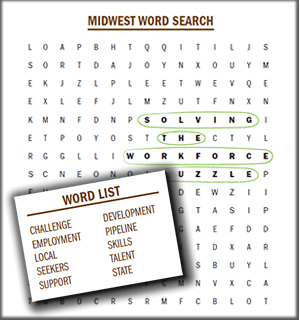In the January 2015 issue of Site Selection, we asked the top workforce development directors in the 12-state Midwest region to answer four basic questions about workforce challenges and how they were tackling them. The questions were:
- What is your state’s biggest challenge in workforce development?
- How is your state working to overcome that challenge?
- What is your state’s ace in the hole, or most strategic advantage, with respect to workforce development?
- What plans are in place to improve your state’s workforce/talent development resources in 2015?
This year, we went back to those directors, or in some cases their successors, to find out how they would answer any of our questions differently. The answers we received were surprisingly candid — in some cases owning up to substantial shortcomings now being addressed.

“Many troubling economic disparities face Minnesotans of color, according to the most recent U.S. Census Bureau report. For example, the median income for African-American Minnesotans fell by 14 percent in a single year. The poverty rate for African-American Minnesotans rose, and Minnesota currently ranks 45th in the U.S. in median African-American household income.
“These figures are going in the wrong direction, which is why we took immediate action to focus on employment disparities in a number of new ways, including the creation of an Office of Career and Business Opportunity. This new office will diversify the state’s workforce by helping workers in communities of color access training and resources for good jobs; providing access to resources and opportunities to minority- and women-owned businesses; and helping the business community develop and adopt hiring and contracting practices that expand opportunities for minority workers and businesses.
“This will dovetail with the state’s existing workforce development programs. In 2014, the DEED served over 204,000 people at statewide WorkForce Centers — and nearly 30 percent were from communities of color. Through our Low Income Worker Training Program, over $2.6 million is being used to train more than 1,300 low-income individuals to help them acquire higher-paying jobs. In addition, Minnesota’s FastTRAC program provided training for more than 1,200 workers last year. This program helps adults with educational barriers prepare for careers in high-demand fields such as health care, manufacturing and transportation. To increase the hiring of Minnesotans with disabilities, state agencies are working toward a goal — set by the governor’s executive order — of 7 percent employment of people with disabilities by all state agencies by 2018.”

“2015 is a continuation of what we saw in 2014. In fact, the dwindling resources and skills gap challenges that we, like many states across the country, are facing seems to be growing — ironically with the good news of the declining unemployment rate. To continue to address these challenges, our work with Certified Work Ready Communities is accelerating, with 64 participating counties and nearly 20 counties fully certified, which has resulted in more than 64,000 individuals receiving the National Career Readiness Certificate. In addition, we have continued our work with the enhancements to Missouri Works Training, having streamlined paperwork and combined resources, we now are working with our community college partners at strengthening capacity.”
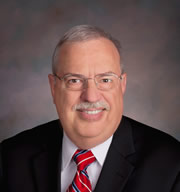
“We have piloted worker availability studies to provide business owners and business leaders with a more comprehensive look at all factors impacting employment, including data beyond just the employment rate. For example, Nebraska has a more educated workforce compared to other states. And while we have discovered worker shortages, these tend to be isolated to particular industries and not across the board. The Department will also stress reemployment programs that better match available job seekers to the vacancies that exist within the job market.
“Nebraska’s high labor force participation rate is indicative of its strong work ethic in both population centers and rural areas crisscrossing the state. We also have discovered that employers prefer to hire from the ranks of the employed. This means that a labor force participation rate of 69.5 percent and an unemployment rate of 2.9 percent actually means that the pool of available talent is much larger than the unemployment rate alone would indicate.”

“With North Dakota’s low population, high labor participation rate and low unemployment, our greatest challenge continues to be a lack of a workforce. We need to not only retain our high school and college and university graduates, but also recruit skilled workers from outside our borders. The more jobseekers learn about North Dakota, the more they seem to realize they can find an incredible qualify of life here.
“The state is working hard to educate our young people of the rich opportunities in North Dakota. Workforce agencies, education and industry are working together to provide career exploration opportunities in middle and high school. To reach out of state job seekers, there are a number of local recruitment efforts taking place with an umbrella initiative through the North Dakota Economic Development Foundation called ‘Find the Good Life in North Dakota.’
“We will continue to recruit from out of state with a focus on military and veterans. The state is also studying our higher education systems to ensure we are aligned with the needs of the state. Finally, continue to educate young people, educators and parents on North Dakota opportunities.”
“Over the last year, Ohio has worked to ensure a more unified workforce system, aligned to the needs of Ohio businesses. The state plays a crucial role in building relationships among employers, training providers, and other workforce stakeholders to ensure that the system works for both businesses and job seekers. We have created the In-Demand Jobs Report — a list of Ohio employers’ most urgent job needs — and aligned resources to meet those needs. We also have developed Industry Workforce Alliances as partnerships of employers, training providers and community leaders to address emerging skill gaps.
“A critical component to developing a skilled workforce is connecting education to careers, and workers to jobs. At the K-12 level, we worked with partners across the state to develop standards for school counselors and to enable more schools to offer college-credit courses. For adults over the age of 22, we are streamlining the process to help them earn their high school diploma. The diploma initiative is coupled with training toward an industry-recognized credential.
“Our public and private colleges and universities, as well as employers, are embedding work experiences (including co-ops and internships) for in-demand jobs into the curriculum of degree programs. And we have made OhioMeansJobs.com — the state’s free, premier job board and career counseling center — the central front door to the state’s many workforce programs.
“As Ohio’s economy continues to improve with 377,000 new private-sector jobs added since January 2011, we are focused on removing barriers to employment. Whether we’re working with veterans, individuals with disabilities or those who live in poverty, we are taking a holistic, individualized approach to removing obstacles and providing quality jobs for Ohioans.
“Ensuring Ohio’s workforce efforts are laser-focused on meeting the job needs of Ohio employers is the foundation of our work. Looking forward, we will build on the state’s 2014 unified workforce plan, and submit a combined state plan that aligns nine federal programs under one strategic vision. We also will continue to strengthen our multi-faceted OhioMeansJobs career counseling and jobs website and leverage our partnerships to break down barriers to employment.”

“Many changes are being made to our online SDWORKS jobs database. Our goal is for the new management information system to be fully functional at this time next year. When the revamping of our job posting and job search database is complete, users will find things to be greatly simplified. The behind the scenes tools will allow job matches to be done based on skills, abilities, education, and experience rather than a generic job code. This will allow employers to more accurately describe who they are looking for, and job seekers will be evaluated on what they can actually do rather than just the titles of the jobs last held. An additional bonus is the public will have greater access to real-time labor market data relevant to workforce trends allowing for more informed personal, career, and policy decision-making.
“Our local office managers are involved in their communities and constantly conduct outreach visits to employers. Additionally, we have challenged the Workforce Development Council to act as a conduit for communities and state agencies to come together to discuss and advance workforce challenges. In the last year, the Council has demonstrated they are up to this task. At the state level, DLR, Department of Education, Governor’s Office of Economic Development, Department of Health, Board of Regents, and the Governor’s Office are working together on common goals. All of these efforts are helping us to better respond to the needs of employers and job seekers alike.
“I am excited about our newly redesigned Dakota Roots website. The goal of the update was to create a simplified, yet visually dynamic platform that helps to tell our story through photos and testimonials of actual Dakota Roots participants. The diversity of the stories will resonate with a wide variety of individuals considering relocating to South Dakota. Other features available on the website include career exploration tools, quality of life facts, a real wage calculator, relocation tips, and information about doing business in South Dakota.
“The data produced by our Labor Market Information Center may be one of our best kept secrets, but we’re working hard to spread the word. There is a wealth of LMI available to businesses, economic developers, HRMs, educators, students, parents, job seekers, policy makers, and more.”
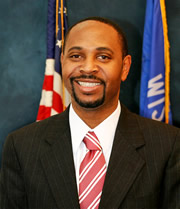
“Under Governor Walker’s leadership, Wisconsin’s economy has continued to grow in 2015. In October, the unemployment rate remained at a 14-year low 4.3 percent, and both our unemployment rate and labor force participation rate consistently outperform the national rates. Even with these positive economic indicators, Wisconsin employers continue to cite a lack of qualified applicants for open positions, which remains one of the top workforce development challenges facing Wisconsin. To address this challenge, Wisconsin continues to support proven methods to develop talent, as well as seek innovative new approaches to grow the workforce and move our state’s economy forward.
“In 2015, we launched of the first phase of our newly redesigned JobCenterofWisconsin.com (JCW) website. JobCenterofWisconsin.com is Wisconsin’s online public labor exchange that’s available to employers and job seekers at no cost, 24 hours a day. Our initial phase of enhancements introduces mobile-responsive design, offers advanced tools for job seekers and employers, and moves the state’s Labor Market Information System (LMIS) toward the ultimate vision of a best-in-class system that uses the latest available data to connect talent with job postings based on skills. We look forward to rolling out additional JCW site enhancements in 2016.
“Building awareness about potential career pathways and talent development programs has been a key focus in 2015. For the first time, Governor Walker proclaimed November as Career Development Month in support of efforts to educate students about in-demand occupations and ensure a robust talent pipeline in Wisconsin for generations to come. He also proclaimed the first week of November as Apprenticeship Week in Wisconsin, urging employers to host events to showcase their apprenticeship programs and engage business, industry, education, community agencies, students, workers and other stakeholders to learn about apprenticeship.
“In 2016 we will continue efforts to pilot Academic and Career Planning (ACP) in select schools across the state. Governor Walker previously signed legislation to provide nearly $1.1 million to school districts to give each student in 6th-12th grade in the 2017-18 school year the opportunity to create an ACP based on his or her interests, bringing career education directly into elementary and middle schools. The year 2016 will be critical as we prepare to launch the ACP statewide in partnership with the state Department of Public Instruction during the 2017-18 academic year.
“Another strategic priority that we will pursue in 2016 to develop Wisconsin’s workforce involves bridging our state’s Youth Apprenticeship and Registered Apprenticeship programs, creating a seamless pathway between both programs so high school students can move into Registered Apprenticeship and, ultimately, gainful employment.
“As this seamless pathway is already taking shape at places such as Lakeshore Technical College with a focus on manufacturing, we will look to expand into construction, health care and information technology. The Wisconsin Apprenticeship Advisory Council established the Career Pathways Advisory (CPA) subcommittee to explore and define how the bridge system will work, identify policies and create a mechanism for replication statewide.
“All of these strategies will be reflected in a combined state plan that DWD submits next year to implement the federal Workforce Opportunity and Innovation Act (WIOA), which represents the most significant reforms to the nation’s workforce development delivery system since the 1990s. WIOA offers an opportunity to bring economic development, workforce development and educational systems into closer alignment to grow the economy, develop the workforce, and move our state forward in 2016 and beyond.”
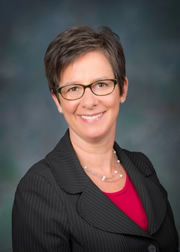
“Building a robust, sustainable talent pipeline that meets employers’ demands is a must if Michigan is to continue its remarkable turnaround. As our aging workforce eyes retirement, we need to replenish our pipeline with enthusiastic, knowledgeable and versatile talent so that employers can grow and create additional jobs.
“Michigan is achieving success through a multifaceted approach that views the workforce development challenge in its totality. There is no single magic bullet to bridging the skills gap. That’s why Michigan attacks this problem on several fronts. For example, we’re addressing public perception issues surrounding the skilled trades; we’re raising awareness of existing job opportunities; we’re harnessing the power of broad, creative and inclusive partnerships; and we’re helping employers provide training for in-demand jobs.
“The vision and commitment of our Governor and Legislature make Michigan a leader in workforce development. Their well-thought strategies and willingness to commit the necessary resources are driving Michigan’s continued progress. Their support allows the state to solve key pieces of the talent puzzle, such as funding a middle-college initiative in which students can earn a high-school degree along with college credits or a certification; and supporting our skilled trades campaign that encourages students to engage in career planning with an eye toward the skilled trades.
“Michigan took several aggressive steps in 2015 to enhance its impressive portfolio of talent development resources. One of its new tools is the Community College Skilled Trades Equipment Fund, through which 18 community colleges were awarded a total of $50 million in early 2015. The program allows eligible community colleges to purchase equipment needed for educational programs in high-wage, high-skill and high-demand occupations. In addition, the Governor and Legislature doubled funding for the successful Skilled Trades Training Program, which promotes employer-responsive training that helps companies build a well-trained, stable and loyal workforce. The program already has far exceeded its targets in terms of job creation and retention.”
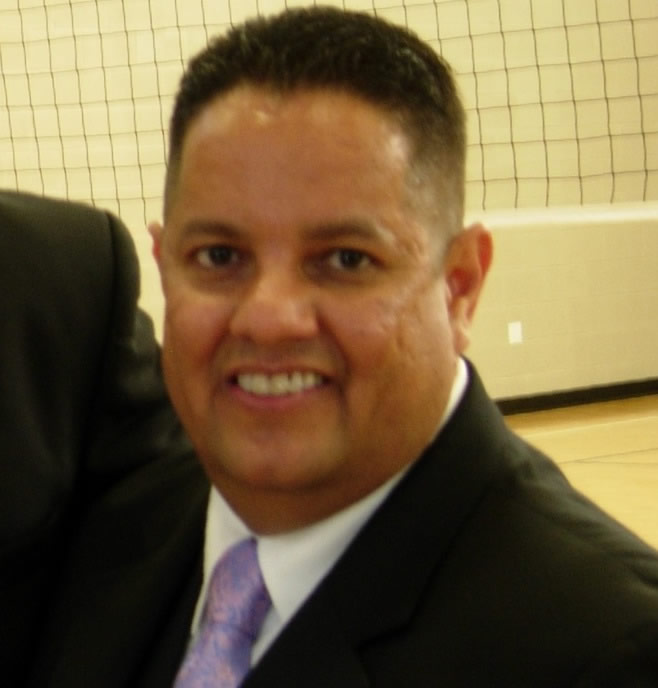
“One year later — Illinois is providing a framework to the state’s economic development regions for developing a set of strategies that will meet a businesses’ need for skilled workers and the workers’ need for good job. This framework is founded on the following vision:
- Business-driven talent solutions that integrate education, workforce, and economic development resources across systems to provide businesses, individuals, and communities with the opportunity to prosper and contribute to growing the state’s economy.
“The work of the last year is providing a solid foundation for moving this vision forward. Using a regionally-based planning process, Illinois is creating a data driven sector strategy framework that supports the systemic assessment of business needs for talent across Illinois 10 economic development regions. This framework will help to ensure that future workforce, education and economic development partnerships are business lead and across the whole talent pipeline.
“Illinois continues to build on our solid business partnerships through our business lead initiatives and will leverage these relationships to inform the expansion of other high-quality partnerships statewide. These partnerships will drive the development of career pathways that meet business needs while offering individuals clear opportunities to build and upgrade their skills and advance their careers over time. Further aligning economic and workforce development with the state’s education goals to increase opportunities for accelerated learning, training and work-based strategies that result in a workforce better prepared for demands of the future.
“Finally, we continue to work closely with businesses and industry associations to move our investments to those that directly support the integration of workforce services into economic development efforts that support job creation and retention strategies and allow businesses to remain competitive.”

